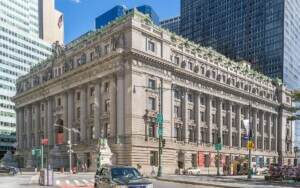This story is part of a monthlong series of guests posts by AIA New York that feature Archtober Building of the Day tours. See the full 2017 schedule here.
For today’s Building of the Day, Archtober took us on a guided architectural tour of the Alexander Hamilton U.S. Custom House, now home to the National Museum of the American Indian (NMAI). Our knowledgeable guide, Jeff Harrington, Museum Ambassador of NMAI, described the building’s history, focusing on the magnificent architecture by Cass Gilbert.
We started our tour in the rotunda, the massive central space that anchors the building. Here, Harrington gave us a run-down of the site’s history. The lower tip of Manhattan Island, acquired by Dutch settlers in the early-17th Century, was the site of the New Amsterdam settlement. The central point of New Amsterdam was Fort Amsterdam, which stood where the Customs House is now. In 1665, New Amsterdam surrendered to the British, who renamed it New York. In 1790, the federal government demolished Fort Amsterdam (then known as Fort George) to build the Government House, which was intended to be the presidential residence but was never actually occupied by George Washington. Government House later became the Governor’s mansion, and from 1799 to 1815 was New York’s second custom house.
In the late 19th and early 20th centuries, customs taxes were the largest source of national income, since income tax and other federal taxes were vastly lower than they are today. Imports to New York Harbor were rapidly mounting, and the Custom House needed a larger home. In 1899, Cass Gilbert won the competition to design the new Custom House. The process was marked by some controversy; his former architectural partner, John Knox Taylor, was the Supervising Architect for the Department of the Treasury and hence on the selection committee. Work began in 1900 and was completed in 1907. As a measure of the Custom House’s importance, the entire land acquisition, design, and construction budget of $9 million was paid for in the first month with Custom income.
Gilbert designed an immense, imposing seven-story edifice with 450,000 square feet of floor space. Unlike almost every other custom house, the entrance faced away from the sea – which at that time, before landfill, was immediately adjacent to the site – and up Broadway. Gilbert wanted the first glimpse of the United States to be not the inside of a government building, however magnificent, but the sweep of Broadway. The myriad offices needed to house 1,000 employees were grouped along corridors leading off from the central rotunda. To the left of the entrance was the cashier’s office, where ships’ officers and importers paid the tariffs that had been set by officials in other parts of the building. To the right was the wood-paneled Collector’s Office, where the Collector of Customs conducted official business.
Gilbert’s attention to detail was legendary; he was involved in the design down to the smallest decoration. He also relied on numerous extraordinary collaborators. Exterior statues of figures personifying America, Asia, Europe, and Africa are by Daniel Chester French. The ceiling of the central rotunda was designed by famed master craftsman Rafael Guastavino, whose other credits in New York include the Oyster Bar at Grand Central Terminal, Grant’s Tomb, and Carnegie Hall. Guastavino was also involved in the construction of the Custom House’s stairs. Much of the paneling in the Collectors Room was done by Louis Comfort Tiffany’s woodworking studio, which he had not yet sold to focus on glass. Gilbert designed the decoration with two central themes: the sea and the U.S. Government. Marine animals and American eagles therefore dominate the ceiling decorations. In 1937, Reginald Marsh carried out a WPA commission to decorate the central rotunda with scenes of New York Harbor, adding to the nautical theme.
As the Port of New York declined after World War II, so did the importance of the Custom House. The post of Collector was abolished in 1966, and in 1971 the Custom House, much reduced in size, moved its offices to 6 World Trade Center. The Hamilton Custom House was slated for demolition, but efforts led by Senator Daniel Patrick Moynihan saved it from the wrecking ball. In 1976, it was listed as a National Historic Landmark, but it remained unoccupied and deteriorated. In the early 1990s, renamed in Hamilton’s honor, it was restored and adapted to house the NMAI, which now occupies the building along with various other governmental agencies such as a divorce court and, once again, a small customs office. Our Archtober group couldn’t have been happier that this magnificent building escaped demolition and can be experienced in its full glory.
Join us tomorrow at the New Lab in Brooklyn Navy Yard!










